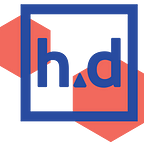The rise of VR/AR, its applications, and its implications
Hack.Chat with Underscore VC
“In the same way that the Internet democratized information, virtual reality can do the same for experiences.” — Richard Dulude, Principal & Investment Manager at _Underscore.VC
Hack.Diversity Fellows asked to learn more about virtual and augmented reality (VR/AR), and NEVCA member firm _Underscore.VC, through the efforts of Cory Bolotsky and Richard Dulude, went above and beyond to deliver. As a result, we flocked together on a Monday night to enjoy hot pizza, cold beer, and a thought-provokingly dynamic conversation led by Dulude and Luna Yuan, a VR entrepreneur out of Harvard Innovation Lab, about the rise of VR/AR, its applications, and its implications.
The Rise of VR/AR
As illustrated by Dulude, the rise of VR is the natural progression of tech evolution. We started off with the programming command line, a one-dimensional interface. Then we advanced to and mastered web development, a 2D interface. Now we’re in the developing stages of building out the 3D metaverse. Most of our Hack.Diversity Fellows, techies that they are, have already tried out some form of VR/AR application available on the market, whether it’s Facebook’s Oculus Rift, Snapchat filters, or even the throwback Virtual Boy, which was released by Nintendo in 1995, and marketed as the first console capable of displaying stereoscopic 3D graphics.
“What is your opinion as to why Virtual Boy failed? — David Alvarado, Hack.Diversity Fellow
Dulude offered that investors will often ask “Why now?”. Back in 1995, the idea was unsubstantiated by the tech underlying it, but nowadays we are past that. Improved camera quality enables visuals to read a lot more realistically. However, Yuan notes that the quality of display screens have some catching up to do before we fully solve for the screen door effect.
Applications
While VR/AR application frontiers are broad, including but not limited to, the education, sports, tourism, real estate, and healthcare industries, Dulude predicts that AR for commerce (i.e. “virtual try-on”) will be the first place for widespread mass adoption. As an example, Dulude passed around his phone for everyone to take turns “trying-on” a makeover complete with red lipstick and false eyelashes via the Sephora app. Another example is WayfairView, an AR app that Hack.Diversity partner company Wayfair developed to allow shoppers to visualize décor in their homes before making a purchase.
The current challenges to building out VR for other industries can fit broadly into two buckets: 1) immersively real presence (i.e. interactivity between individual users’ experiences, linking visuals with your other senses) and 2) who’s going to pay for it?
Implications
Do investors care how VR is applied? — JohnPaul Kambazza, Hack.Diversity Fellow
With unexplored territory comes exciting possibilities, but also undefined ethical best practices. The same VR experience that would bring medical students all over the world into the operating room to observe a complex surgery could be applied to forcing an individual to face their worst fears. “After all,” Yuan mused, “If I could experience everything I wanted through VR, would you care to ‘actually’ experience it? If human experiences can be made and shared in VR, it makes no difference to your brain.”
An emphatic THANK YOU to Rich Dulude, Luna Yuan, Cory Bolotsky, and the entire _Underscore.VC family for hosting the event, dropping valuable knowledge currency, and integrating us further into Boston’s tech community!
Want to partner with us for an event? Let us know at info@hackdiversity.com. Engage with us on Facebook, Instagram, LinkedIn, Twitter, Website, and Support!
